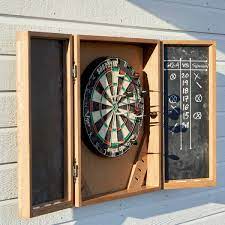Dartboard measurements and sizes are the same whether you're looking for a regular novice dartboard or a skilled dartboard, with the (precise) regulatory dartboard size being 17344 inches or 45.1cm in diameter, however, you could see this adjusted up to 18 inches or 45.7cm on occasion. Dartboards are required to have an overall diameter of17.75" (451 mm), a depth of1.5" (38.1 mm), and a weight of 10-12 lb (4.54-5.44 kg). A dartboard is a spherical target that is set against the wall with the bull's eye at eye level that's used to collect darts when playing Darts. Usually, a dartboard is divided into 20 pieces. A thin metal divides each section, which is labeled with a number. Dartboards are typically made of compressed sisal fibers or boar bristles, as well as cork. The external of a Dartboard is sanded even and printed with numerous colors. A dartboard with dartboard measurements of 1.5 inches (3.81cm) thick and sits 1.5 inches (3.81cm) away from the wall or stand on which it is placed.
Hot selling dartboard measurements and uses:
Dartboard measurements of SZX-DBC003 model when closed and open are 20.9" 23.2" 3.5" (53058989MM) 42.1"x23.23.5" (107058989MM) respectively. And he second model is SZX-DBC006, dartboard measurements of this article when closed and open are 20.9" 27" 3.38" (53068586MM), 42.5"x27.32" (108068586MM) respectively. Dartboard SZX-DBC003 model has material of 15mm foamed board with exterior generally pro paint on the front and aluminum plastic board on the back. Dartboard measurement of this board shows that the darts inserted inside are both decorative and protective of the wall. It is packed after getting the items without their own installation, it simply takes three minutes to hang them. It has a leaderboard on which you may play and keep track of your score with friends and others. It may be utilized in living rooms, garages, basements, and backyards, as well as bars, game rooms, and other amusement parks. And the second model’s SZX-DBC006, dartboard measurements show it has 13mm MDF with a reasonable thickness, and the darts inserted inside are both decorative and protective of the wall. After getting the items without their own installation, it simply takes three minutes to hang them. It has a leaderboard where you may keep track of your progress while playing. Make a list of the score with your friends and others. It may be utilized in living rooms, garages, dungeons, backyards, and also pubs, playrooms, and other music venues.
Numberings on the dartboard according to the dartboard measurement:
The patterning on a conventional dartboard is meant to limit the likelihood of "lucky shots" and the element of chance. The numbers are arranged in such a way that precision is encouraged. That is all there is to it. It's that simple. Inaccuracy is punished by placing tiny numbers on either side of high numbers, such as 1 and 5 on either side of 20, 3 and 2 on either side of 17, and 4 and 1 on either side of 18. As a result, if you aim for the 20 sections, a lack of precision or focus will result in a 1 or a 5. Gamlin's arrangement of the numbers is practically ideal, given that there are 2,432,902,008,176,640,000 various conceivable arrangements of the 20 segments on a normal dartboard. The leading edge of the dartboard is suggested for individuals new to the game of darts since there are proportionately more high numbers clustered there, i.e., 16, 8, 11, 14, 9, and 12. With this strategy, you won't get any big scores, but you won't get any 5s or 1s. Many publications credit BRIAN GAMLIN with "inventing" the contemporary standardized dartboard numbering scheme. According to several so-called darts authors, Gamlin was a carpenter from Bury, Lancashire, England, who invented the irritating sequence in 1896, when he was 44 years old. He died in 1903 before the invention could be patented.
Height and dartboard measurements:
The length of the dart board is 1.73m from the floor to the centre of the bullseye. The oche (throw line) is 2.37 metres away from the front of the dart board (2.43m for electronic dart boards). You can use an Oche Sticker, Lazor Approach shot, or a strip of adhesive to denote the edge of the pool. Using a portable dartboard stand, you may simply raise your dartboard to the appropriate height off the floor. These supports are simple to assemble and disassemble, which is great if you want to store the board while not in use. Alternatively, you may prefer a wall-mounted setup, which is common in pubs and other places and provides a more permanent option. If you prefer this alternative, our PINPOINT dartboards come with suspending bracket attachments that make putting up a dartboard a breeze. For dartboard measurements most of the measurements that take into consideration are its width or Diameter, typical depth weight in kilograms or pounds its circumference in centimeters, Height of Bullseye in centimeters measurement from center to outside Treble in milli meter, Center to Outside Double in milli meter, Double & Treble Rings measurement again in milli meter, Outer Bullseye Diameter in mm, Center to Outside Treble in mm Center to Outside Double in milli meter.
Read more: What is the procedure for making dart boards?
Conclusion:
It is concluded that whether you're searching for a standard amateur dartboard or an experienced dartboard, the dartboard measurements and sizes remain the same. Thus, Board for darts Height is 5 feet tall. The distance from the floor to the center of the bull's-eye is 8 inches. The space from the dartboard's front to the throwing line subsists: Soft Tip: 8 feet and 0 inches, Steel Tip: 7 feet 9 1/4 inches. A simple piece of tape will enough to designate the throw line.



